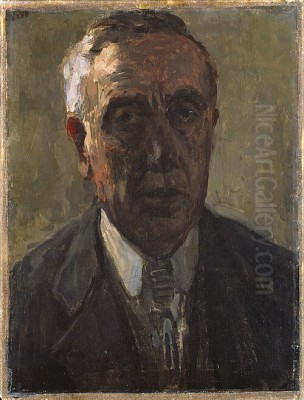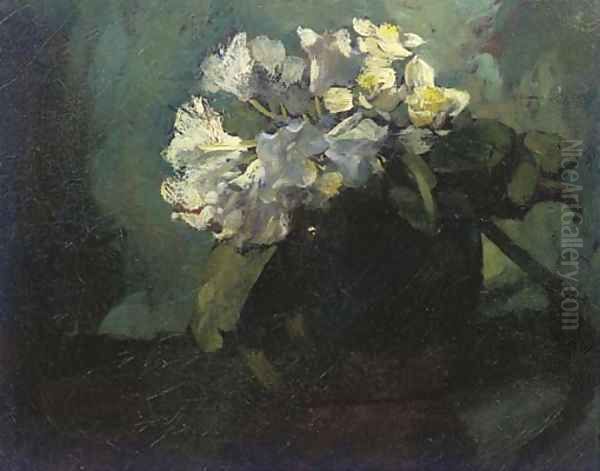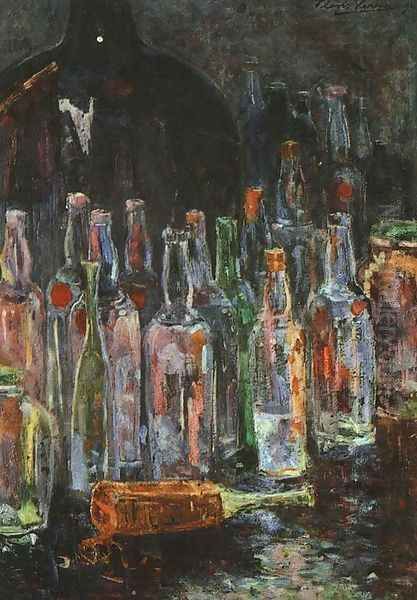
Floris Hendrik Verster stands as a significant figure in Dutch art history, bridging the late 19th-century traditions with the burgeoning movements of the early 20th century. Born in Leiden in 1861 and passing away under mysterious circumstances in 1927, Verster carved a distinct path, becoming particularly renowned for his evocative still life paintings, especially those featuring flowers. His work reflects a deep engagement with Dutch artistic heritage while simultaneously embracing contemporary European influences, positioning him as a key artist within the Dutch Post-Impressionist milieu. His journey through different styles and techniques, his connections with prominent artists of his time, and the enduring appeal of his work contribute to his lasting legacy.
Early Life and Artistic Formation
Floris Verster's entry into the world of art was perhaps predisposed by his family environment. He was born into a family with strong cultural and scientific inclinations. His father, Abraham Florentius Verster van Wulverhorst, was a respected administrator at the National Museum of Natural History in Leiden (now Naturalis Biodiversity Center). More than just an administrator, his father was also an accomplished amateur artist, known for his sketches and paintings, particularly of birds, reflecting his passion for ornithology. This environment undoubtedly fostered an appreciation for observation and artistic expression in the young Floris.
His formal artistic training began locally in Leiden at the society drawing school Ars Aemulorum Naturae ('Art Rivals Nature'). Seeking more advanced instruction, he subsequently enrolled at the prestigious Royal Academy of Art in The Hague. This period, roughly from 1880 to 1884, was crucial for honing his technical skills. During his time in The Hague and shortly thereafter, he shared experiences and likely studios with fellow students who would also become notable figures in Dutch art, including the influential painter George Hendrik Breitner. He also received private lessons for about six months from Breitner in Leiden.

Further enriching his early development was his close relationship with his future brother-in-law, Menso Kamerlingh Onnes, himself a painter. They shared a studio in Leiden for a time, providing a space for mutual influence and artistic exploration. This period laid the groundwork for Verster's technical proficiency and exposed him to the prevailing artistic currents of the time, particularly the lingering influence of the Hague School.
Influences and Initial Style
Like many Dutch artists of his generation, Verster's early work bore the imprint of the Hague School. This movement, dominant in the latter half of the 19th century, was characterized by its realistic depictions of Dutch landscapes, peasant life, and coastal scenes, often rendered in muted, atmospheric tones. Artists like Jacob Maris, Anton Mauve, and Jozef Israëls were leading proponents, emphasizing mood and light over precise detail. Verster absorbed this sensitivity to atmosphere and the preference for everyday subjects.
However, Verster soon looked beyond the confines of the Hague School. He developed a keen interest in French Realism and related movements. He spent time in Brussels around 1882, broadening his horizons. Significantly, he shared a studio in Leiden for a period with painters influenced by French realism, specifically mentioning Antoine Vollon and Théodule Ribot as artists whose work resonated with him. Vollon, in particular, was known for his rich still lifes and impasto technique, which may have encouraged Verster's own explorations in the genre.
A pivotal influence throughout his career was George Hendrik Breitner. Initially a fellow student and later a close friend, Breitner became a leading figure of Amsterdam Impressionism (often considered a form of Dutch Post-Impressionism). Breitner's dynamic, often gritty depictions of urban life and his bold brushwork offered a powerful counterpoint to the more subdued Hague School aesthetic. Verster's association with Breitner and other contemporaries like Isaac Israëls and Willem de Zwart connected him to the more progressive trends emerging in Dutch art.
These diverse influences – the atmospheric realism of the Hague School, the textural richness of French-inspired still life, and the dynamic energy of Amsterdam Impressionism – coalesced in Verster's evolving style. He began to move away from pure landscape, developing a looser brushstroke and showing a growing interest in the tactile qualities of paint and the expressive potential of color.
Evolution Towards Still Life

While Verster produced landscapes throughout his career, his artistic identity became increasingly defined by his mastery of still life. This shift appears to have gained momentum in the late 1880s. Initially, his still lifes might have retained some of the darker tonalities associated with the Hague School, but they soon evolved towards a brighter palette and more assertive compositions.
Flowers became a recurring and central motif in his still life work. Unlike the highly polished, minutely detailed floral arrangements of the Dutch Golden Age, Verster's approach was more modern. He focused on the texture, color, and form of the blooms themselves, often depicting them in simple vases or settings. His brushwork became more visible, contributing to the vibrancy and immediacy of the image.
This transition towards still life allowed Verster to concentrate on formal elements – color relationships, composition, the play of light on surfaces, and the materiality of paint itself. It provided a vehicle for exploring the expressive possibilities that fascinated many Post-Impressionist artists across Europe. His dedication to this genre would ultimately secure his reputation.
The Pastel Period and Modernist Leanings
A distinct and highly regarded phase in Verster's oeuvre occurred between approximately 1892 and 1900 (some sources suggest 1892-1895). During this time, he largely set aside oil painting and concentrated almost exclusively on working with colored wax crayons (pastels) on paper. This period marked a significant stylistic development, moving towards what is often considered an early form of Dutch Modernism.
The works from this period are characterized by their intimacy, tranquility, and innovative technique. Subjects often included serene floral still lifes and quiet landscapes. The use of wax crayons allowed for both delicate lines and dense blocks of color, creating unique textural effects. Verster applied the crayons thickly, sometimes scratching into the surface, achieving a rich, almost tapestry-like quality.
A prime example from this era is Het Warmonderhek (The Warmond Gate/Fence), created around 1893-1894. This pastel drawing depicts a simple wooden gate in a landscape setting, but its flattened perspective, emphasis on pattern, and subtle color harmonies mark it as a departure from traditional realism. It is often cited as one of the seminal works of early Dutch Modernism, showcasing Verster's willingness to experiment and push stylistic boundaries. The works from this pastel period possess a quiet intensity and a focus on decorative qualities that align them with Symbolist and Art Nouveau tendencies emerging elsewhere in Europe.
After this intense period of experimentation with pastels, Verster gradually returned to oil painting around 1900, though the lessons learned during his crayon phase – particularly regarding color and composition – continued to inform his later work.
Mastery of Still Life
Floris Verster is arguably best remembered as a master of the still life genre, particularly floral subjects. His approach evolved throughout his career, but consistently demonstrated a profound sensitivity to color, texture, and light. He moved beyond mere representation to imbue his subjects with a vibrant presence.
His flower paintings are celebrated for their rich, often bold, color palettes and expressive brushwork. Works like Still Life with Peonies (various versions exist, often dated around the late 1880s or 1890s) exemplify his skill. These paintings often feature lush arrangements of peonies, capturing the delicate yet voluminous forms of the petals. Verster employed thick applications of paint (impasto) in some areas, contrasting with smoother passages, giving the flowers a tangible quality. Descriptions often highlight shimmering golden tones set against deep greens or other resonant background colors, creating a powerful visual impact.
Another notable example is Zinnias in a vase. Like his peony paintings, this work showcases his ability to capture the specific character of different flowers. The vibrant, almost geometric shapes of the zinnias are rendered with confidence and a keen eye for color interaction. His compositions, while often seemingly simple – a vase of flowers on a surface – are carefully constructed, balancing form, color, and negative space.
Verster's still lifes stand apart from both the meticulous detail of earlier Dutch masters and the purely analytical approach of some forms of modernism. They retain a connection to observable reality but are infused with subjective feeling and a delight in the purely visual qualities of the subject and the medium. His work in this genre secured his place as one of the foremost Dutch still life painters of his era.
Connections and Artistic Milieu
Floris Verster was not an isolated artist; he was actively engaged with the artistic currents and personalities of his time. His friendships formed during his studies, particularly with George Hendrik Breitner, Isaac Israëls, and Willem de Zwart, were significant. These artists were central figures in the development of a distinctly Dutch form of Impressionism and Post-Impressionism, often centered around the dynamic urban environment of Amsterdam, though Verster himself remained largely based in Leiden.
A crucial connection for Verster was his involvement with the Brussels-based avant-garde group Les XX (Les Vingt, or The Twenty), founded in 1883. Verster exhibited at their prestigious annual salons, which were vital platforms for showcasing progressive art from across Europe. Participating in Les XX placed Verster in direct contact with leading Belgian artists like James Ensor and Guillaume Vogels, as well as international figures. The Dutch artist Jan Toorop was also closely associated with Les XX. This involvement exposed Verster to Symbolism, Neo-Impressionism, and other cutting-edge styles, undoubtedly influencing his own experimental tendencies, particularly during his pastel period. His participation helped bridge the Dutch art scene with broader European developments.
Verster also cultivated relationships with patrons. Notably, he had connections with Helene Kröller-Müller, who, along with her husband Anton Kröller, would become one of the most important collectors of modern art in the Netherlands (their collection forms the basis of the Kröller-Müller Museum). Verster painted portraits of Helene, and she reportedly posed for him frequently in his studio. There are accounts of them traveling together, suggesting a supportive relationship between artist and patron.
These connections – with fellow Dutch innovators, the international avant-garde via Les XX, and influential patrons – were integral to Verster's career, providing stimulus, exhibition opportunities, and support.
Recognition and Legacy
Floris Verster achieved considerable recognition during his lifetime and remains a respected figure in Dutch art history. His primary achievement lies in his contribution to still life painting, revitalizing the genre with a modern sensibility while honoring its rich Dutch tradition. He successfully synthesized influences from the Hague School, French Realism, and contemporary Post-Impressionist trends into a unique personal style.
His works were acquired by major institutions, including the Rijksmuseum in Amsterdam, confirming his status within the canon of Dutch art. Publications dedicated to Dutch art of the period, such as those discussing the Hague School's successors or the rise of Post-Impressionism in Holland, regularly feature his work and acknowledge his importance. His innovative pastel drawings of the 1890s are specifically highlighted for their role in the early development of Dutch Modernism.
Verster's paintings continue to be appreciated by collectors and the public. His works appear at auction, sometimes fetching significant prices. The reported sale of Het Warmonderhek for €72,500 at an Amsterdam auction underscores the market's recognition of the importance and quality of his output, particularly from his experimental phases. While perhaps not as internationally famous as some of his contemporaries like Van Gogh (whom he likely encountered through Les XX connections) or Mondrian, Verster holds a secure place within the narrative of Dutch art's transition into modernity.
His legacy resides in his beautifully crafted paintings, particularly his still lifes, which demonstrate a masterful handling of color and texture, and in his role as an artist who navigated the complex artistic landscape at the turn of the 20th century, contributing significantly to the vibrancy of Dutch Post-Impressionism.
Later Years and Unexplained Death
After his intensive period working with pastels around the turn of the century, Floris Verster returned primarily to oil painting. He continued to produce still lifes and landscapes, maintaining his high standards of craftsmanship. He remained based in Leiden, working from the studio he established in his home after his marriage to Jenny Kamerlingh Onnes in 1892.
His life came to a sudden and tragic end. On January 21, 1927, Floris Verster was found deceased in a pond near his home in Leiden. The exact circumstances surrounding his death remain unclear, leading to speculation. Whether it was an accident, suicide, or another cause has never been definitively established, adding a layer of mystery to the conclusion of his life and career. He was 65 years old.
Conclusion
Floris Hendrik Verster occupies a vital position in the story of late 19th and early 20th-century Dutch art. Emerging from an artistic family and educated within the established academic system, he absorbed the lessons of the Hague School before forging his own path. Influenced by French Realism and contemporaries like George Breitner, and engaging with the international avant-garde through Les XX, he developed a distinctive style characterized by rich color, expressive brushwork, and a profound sensitivity to his subjects.
He excelled particularly in the genre of still life, breathing new life into floral painting with a modern sensibility that balanced observation with personal expression. His experimental phase with pastels in the 1890s marked him as an early proponent of Dutch Modernism. Through his connections, exhibitions, and the enduring quality of his work, Verster made a significant contribution to the artistic landscape of his time. Though his life ended enigmatically, his paintings remain, testifying to a dedicated artist who masterfully navigated the transition from 19th-century realism to the dawn of modern art in the Netherlands. His work continues to be admired for its beauty, technical skill, and quiet intensity.